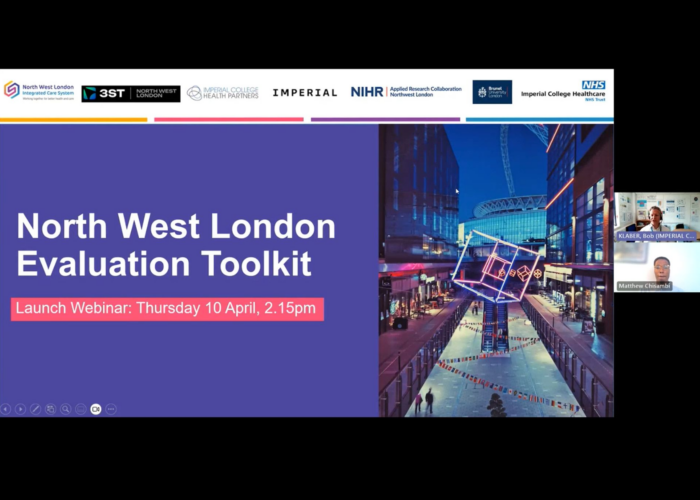 ICHP has worked with partners to publish a guide to population segmentation analysis, one of the key strands making up population health management (PHM). In this post we look at the importance of segmentation and PHM to integrated care systems across the UK and how they can help keep people healthy for longer.
ICHP has worked with partners to publish a guide to population segmentation analysis, one of the key strands making up population health management (PHM). In this post we look at the importance of segmentation and PHM to integrated care systems across the UK and how they can help keep people healthy for longer.
There is a growing drive within integrated care systems (ICSs) across the country to start delivering a population health management approach to promoting health and wellbeing. Here at ICHP we’ve been working with individual ICSs and the primary care networks within them to support the roll-out of PHM, and we’ve also been involved in a recent project to publish a guide to using population segmentation as part of the PHM process.
Our team joined with experts from the Care Quality Commission, Department of Health and Social Care, NHS Digital, NHS England and NHS Improvement, NHSX, Public Health England, The Health Foundation, The King’s Fund and The Nuffield Trust to create the guide.
It is packed full of practical advice and examples of population segmentation and PHM in action that we hope will both inform and inspire everyone involved in PHM, including NHS systems, local authorities, commissioners and providers, so they can apply the approach in their own area.
What is population segmentation?
Population segmentation is a type of analysis that allows us to separate populations into subgroups so that we can better assess each group’s wants, needs, and health priorities.
The different types of population segmentation include:
| Type | Pros | Cons |
| Whole-population segmentation | · Targets whole population
· Good for national care planning |
· Subgroups might not be well represented
· Expensive to undertake · Might miss personalised care needs |
| Sub-population segmentation | · Targets subsets of the entire population and allows packages of care to be defined around needs
· Can be done as a second stage after whole-population analysis |
· Does not give a picture of the whole population; based on assumptions; if starting with this method, a system could end up prioritising low-opportunity areas |
| Audience segmentation | · Targets a specific audience (e.g. patients)
· Messages are focussed on the audience · Generally used to educate or provide moral support |
· Cannot target all conditions
· Patients do not always find this approach acceptable · Perceived messages might not be put into practice by the audience |
| Outcome-based segmentation | · Focused on the end result of an intervention
· Can yield quantifiable results to monitor progress · Can be used to show value for money |
· Narrow focus on outcome only
· May overlap with other segments |
| Geodemographic segmentation | · Good for targeting a specific geography | · Can overlap with whole population segmentation |
Such segmentation is an essential step on the path to population health management, helping health and care systems to identify the most effective interventions for each part of their local population and to design services that deliver those in the most efficient way.
Population health management isn’t just the domain of the NHS; it’s much broader, encompassing all the wider determinants of health and where possible should include education, employment and the environment, involving colleagues from local authorities, public health and beyond. Integrated systems can use population segmentation to identify and prioritise specific populations to shift their focus to targeted prevention and reducing health inequalities.
How does segmentation benefit local people and services?
Population segmentation is really important for ICSs, as it not only helps target sections that may need more support with their health, it also helps them best understand the ‘healthy’ population. This will allow for more resources to be directed ‘up stream’ away from just the medical pathway and to support more prevention and help deal with the larger underlying problems.
Population segmentation is helpful in intelligence-led planning for population health management. Segmentation will allow systems to look for variation in care and outcomes, and if there is any variation, whether it is expected or not. The results should be considered in the wider context of the system to reveal gaps, opportunities and impact on care.
Systems can also use the results of the analysis to look at the current system and where it is not meeting people’s needs. In this way, when the population segments are created and risk stratification is then applied, specific segments can be prioritised with proactive and targeted interventions and tailored management plans. This supports the goal of more personalised care in the NHS Long Term Plan.
Case studies in the guide highlight work in Harrow, where the population segments chosen to be targeted were elderly people, including the healthy elderly segment to improve preventative care; work in Leeds which is targeting frailty and has a key learning of ‘think big but start small’; work in Liverpool that has targeted ‘complex lives’ as a key priority area; and Delaware, US, which used whole-population segmentation to address the cost drivers in the system.
Do analysts need integrated data?
The guide outlines a number of different types of population segmentation, and while few ICSs are able to carry out whole population segmentation as they don’t have integrated data, there are a number of segmentation techniques that they can use right away.
For example, geodemographic segmentation, which can target a geographic area, uses outcomes data from primary and secondary care, and audience segmentation, which targets a particular audience with messages and is generally used to educate or provide moral support, uses tools such as Acorn and Mosaic.
I hope that this new guide will help anyone working in PHM to enrich their work and support them to get started with the data they have now. There’s much more information on PHM on our website including a blog on taking PHM from a buzzword to a real enabler for change in primary care and a key resources page. You can also contact our team.
The full version of the population segmentation analysis guide is available at https://future.nhs.uk/nationalsegmentation/view?objectId=18093296
Post by Andi Orlowski, Deputy Director of Business Intelligence.



